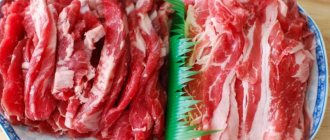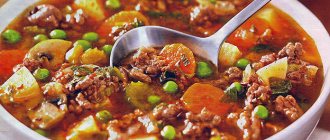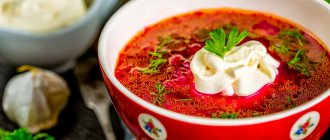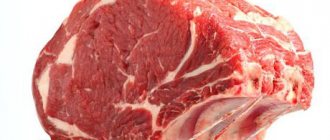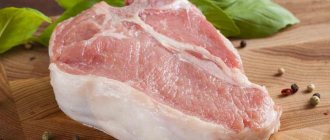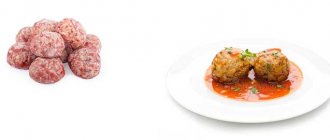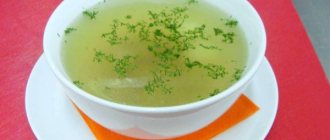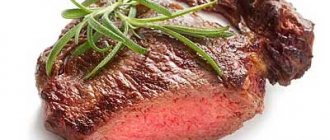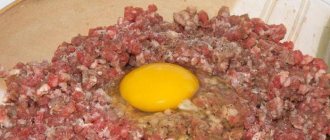Learn how to cook delicious beef broth
It is only at first glance that it seems that there is no simpler process than preparing broth. In fact, there are some subtleties here, and they must be taken into account. First of all, it is worth noting that beef broth in culinary circles is divided into 2 types:
- white;
- red.
The broth turns white if you cook it with the addition of vegetables. And it turns red when the beef is pre-fried a little. In addition, the dish takes on a red tint if you add purple onions or tomatoes during cooking.
On a note! Beef broth is an integral part of the diet of people who have undergone surgery. It is much healthier than pork, since beef has little fat, but a lot of protein.
There are three more simple secrets with which beef broth becomes a real culinary masterpiece:
- The onion added during the cooking process will help give the broth an appetizing color and alluring aroma.
- Dried vegetables and mushrooms, as well as basil, harmoniously complement the taste of the dish. And of course, don’t skimp on the greens.
- Broth made from beef pulp rather than bones will be healthier. This is due to the fact that heavy metal salts accumulate in the bones, and they are harmful to our body.
On a note! Beef broth can be classified as a dietary dish. Its calorie content varies from 4 to 60 Kcal depending on the ingredients added.
How and what kind of meat to choose
The issue of choosing meat is important both for those losing weight and for those undergoing rehabilitation after an illness or surgery. The fattest parts are:
- tenderloin (218 kcal/100 g);
- brisket (225 kcal/100 g);
- arable land (225 kcal/100 g).
The neck and ribs are also high in fat (due to bones and bone marrow). The least calorie content is the shoulder blade and the hip part (137 kcal/100 g).
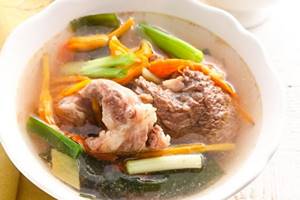
When buying beef at the market or in a store, you should pay attention to the appearance and smell emanating from the meat. The color should be bright red, even, without spots or darkening. The lighter the shade, the younger the animal was. The color of the fat layers will also indicate age. White veins confirm youth, but a yellowish tint signals the “honorable” age of a cattle representative.
It doesn’t hurt to sniff the piece you like. A faint meaty smell is a guarantee of freshness. But additional aromas in the form of vinegar, onions or spices will tell about the seller’s attempts to hide expired products.
Important! The absence of odor is an indicator of a large number of chemical additives that were introduced into the animal’s food to accelerate its growth.
Classic recipe
Let's start with the classic method of preparing beef broth. It can become the basis for delicious first courses. And if you want to improve your digestive process, then eat it as an independent dish.
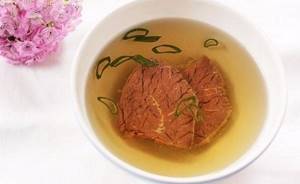
Compound:
- 1 kg boneless beef shin;
- leek;
- onion;
- 1-2 laurel leaves;
- 3 clove inflorescences;
- 100 g carrots;
- salt;
- 4-5 peas of allspice.
Preparation:
- Wash the beef pulp and place it in a deep saucepan.
- Fill the meat with filtered water. It should cover the beef completely.
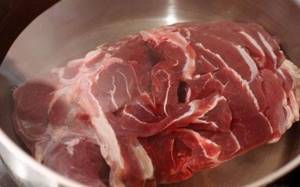
- Place the pan with beef on the stove.
- In the meantime, let's take care of the vegetables. Peel the carrot root, rinse it and cut it lengthwise into ladles.
- We wash the leeks and clean the onions. Let's prepare the spices.
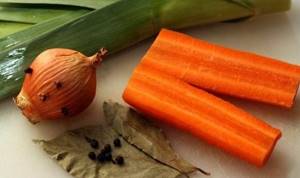
- When the broth begins to boil, foam will form on the surface. We'll definitely take it off.
- Let's reduce the burner level. We make sure that the broth does not boil, but, as they say, is on the verge of boiling.
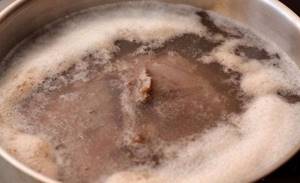
- Then put leeks and onions, carrots, bay leaves, cloves and peppercorns into the pan, and add salt.
- Cook the broth on the lowest burner level for an hour.

- After an hour, remove the vegetables, as well as all the spices, and throw them away. They played their role.

- Cook the broth for another 35-40 minutes.
- Strain the finished broth using gauze and remove all excess fat. Ready! We serve it to the table with greens.
Calories in beef broth on the bone. Chemical composition and nutritional value.
Nutritional value and chemical composition of “beef broth on the bone.”
The table shows the nutritional content (calories, proteins, fats, carbohydrates, vitamins and minerals) per 100 grams of edible portion.
| Nutrient | Quantity | Norm** | % of the norm in 100 g | % of the norm in 100 kcal | 100% normal |
| Calorie content | 28.6 kcal | 1684 kcal | 1.7% | 5.9% | 5888 g |
| Squirrels | 4 g | 76 g | 5.3% | 18.5% | 1900 g |
| Fats | 1.3 g | 56 g | 2.3% | 8% | 4308 g |
| Carbohydrates | 0.2 g | 219 g | 0.1% | 0.3% | 109500 g |
The energy value of beef broth on the bone is 28.6 kcal.
Primary Source: Created in the application by the user. Read more.
** This table shows the average levels of vitamins and minerals for an adult. If you want to know the norms taking into account your gender, age and other factors, then use the “My Healthy Diet” application.
health-diet.ru
Aromatic rich broth
Consider a recipe for delicious and aromatic beef bone broth. The secret to its incredible taste is pre-roasting the vegetables. If you want to give the dish a rich color, add an unpeeled onion to it. Feel free to experiment with greens, for example, add a little dill or arugula to the broth.
Advice! Beef bone broth is an ideal base for aspic because it contains gelatin. Just keep in mind that this dish will look cloudy.
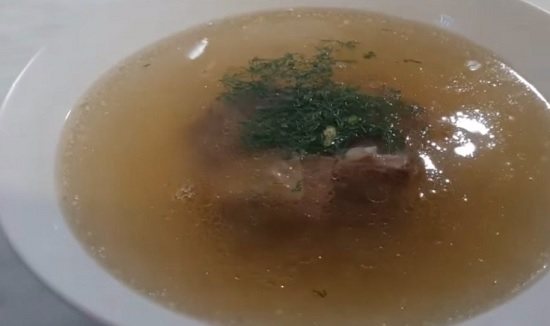
Compound:
- beef shank – 0.6-0.7 kg;
- onion;
- carrot root vegetable;
- 3-4 cloves of garlic;
- parsley;
- basil;
- 4-5 peas of allspice;
- salt.
Preparation:
- Wash the shank and place it in a saucepan. Fill it with water and wait until it boils.

- Then remove the meat and drain the water.
- Fill the shank with clean water and bring to a boil under a closed lid.
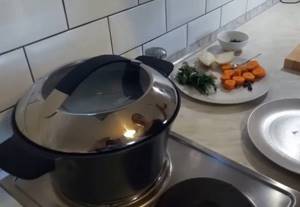
- Let's do the vegetables. Peel, rinse and dry the carrot roots.
- Peel the garlic cloves. We do not peel the onion, cut it into halves.
- Heat a dry frying pan and put carrots, garlic cloves and onions in their husks into it.
- Brown the vegetables on one side, then turn them over to the other.
- Lightly fry the vegetables and place on a plate.
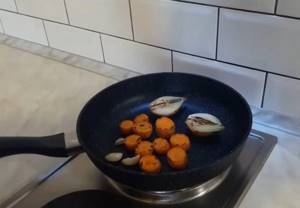
- As soon as the broth comes to a boil, reduce the burner level and skim off any foam that appears.
- Cook the broth for half an hour with the lid closed.
- Now put the vegetables in the pan, add the washed greens and peppercorns.
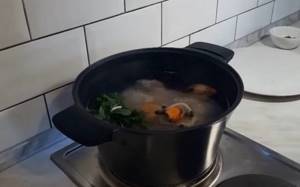
- Salt the broth and simmer the beef until the flesh is easily separated from the bone.
- Strain the finished broth and pour into plates. Let's decorate it with greenery. Ready!
How many calories are in the broth?
- 100 g of chicken broth contains 2 g of protein, 0.5 g of fat, 0.3 g of carbohydrates. The energy value of such a product is 15 kcal;
- 100 g of mushroom broth contains 0.2 g of protein, 0.02 g of fat, 0.85 g of carbohydrates. Energy value – 4.28 kcal;
- Per 100 g of vegetable broth there are 0.65 g of protein, 0.18 g of fat, 2.36 g of carbohydrates. Energy value does not exceed 12.85 kcal;
- In 100 g of fish broth from low-fat fish (for example, hake), the amount of protein is 4.49 g, fat - 0.61 g, carbohydrates - 0.71 g. Energy value - 26.15 kcal;
- Pork broth contains the most calories. 100 g of this dish contains 23.15 g of protein, 8 g of fat, and no carbohydrates. Energy value – 40 kcal;
- The calorie content of beef broth may vary. If the broth is cooked from the pulp, then per 100 g of the finished dish there will be 2.3 g of proteins, 1.1 g of fat, 2.6 g of carbohydrates. The energy value in this case will not exceed 28.8 kcal.
Broth with mushroom notes
Try making beef broth with mushrooms. You can use any mushrooms you like.

Compound:
- 2 liters of mineral water;
- 500 g beef;
- 300 g mushrooms;
- onion;
- salt;
- 4-5 peas of allspice.
Preparation:
- We wash the beef.
- Fill it with water and bring to a boil, skim off the foam.
- In the meantime, clean, rinse and coarsely chop the mushrooms.
- Peel the onion.
- Add mushrooms and onions to the boiling broth.
- Salt and add peppercorns.
- Cook the broth until the beef is cooked. It will take 1.5 – 2 hours.
- Strain the finished broth and discard the onion.
Main conclusions
Beef is an ideal diet product due to its composition and low calorie content:.
- Diet soup is prepared from lean meat with a minimum of ingredients.
- The lowest calorie broths are obtained from the shoulder blade and hip part.
- When choosing meat for soup, you need to pay attention not only to the appearance, but also to the smell.
- The best additional ingredients would be vegetables and cereals.
Making soups from this type of meat is easy. They can easily become the basis of both individual and family dinner menus.
We are waiting for your comments about recipes and secrets of preparing delicious dietary soups.
Beef broth recipe. Calorie, chemical composition and nutritional value.
Beef broth
is rich in vitamins and minerals such as: vitamin B2 - 12.7%, vitamin B5 - 15.2%, vitamin B12 - 101.2%, vitamin PP - 13.2%, cobalt - 15.2%, copper - 11.6%, selenium - 12%, chromium - 17.6%
- Vitamin B2
is involved in redox reactions, helps to increase the color sensitivity of the visual analyzer and dark adaptation. Insufficient intake of vitamin B2 is accompanied by impaired condition of the skin, mucous membranes, and impaired light and twilight vision. - Vitamin B5
is involved in protein, fat, carbohydrate metabolism, cholesterol metabolism, the synthesis of a number of hormones, hemoglobin, promotes the absorption of amino acids and sugars in the intestines, and supports the function of the adrenal cortex. A lack of pantothenic acid can lead to damage to the skin and mucous membranes. - Vitamin B12
plays an important role in the metabolism and transformation of amino acids. Folate and vitamin B12 are interconnected vitamins that are involved in hematopoiesis. A lack of vitamin B12 leads to the development of partial or secondary folate deficiency, as well as anemia, leukopenia, and thrombocytopenia. - Vitamin PP
is involved in redox reactions of energy metabolism. Insufficient vitamin intake is accompanied by disruption of the normal condition of the skin, gastrointestinal tract and nervous system. - Cobalt
is part of vitamin B12. Activates enzymes of fatty acid metabolism and folic acid metabolism. - Copper
is part of enzymes that have redox activity and are involved in the metabolism of iron, stimulates the absorption of proteins and carbohydrates. Participates in the processes of providing oxygen to the tissues of the human body. Deficiency is manifested by disturbances in the formation of the cardiovascular system and skeleton, and the development of connective tissue dysplasia. - Selenium
is an essential element of the antioxidant defense system of the human body, has an immunomodulatory effect, and is involved in the regulation of the action of thyroid hormones. Deficiency leads to Kashin-Beck disease (osteoarthritis with multiple deformities of the joints, spine and limbs), Keshan disease (endemic myocardiopathy), and hereditary thrombasthenia. - Chromium
is involved in the regulation of blood glucose levels, enhancing the effect of insulin. Deficiency leads to decreased glucose tolerance.
morehide
You can view a complete directory of the healthiest foods in the “My Healthy Diet” app.
health-diet.ru
